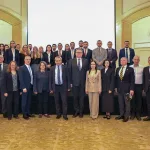Jerusalem, 9 September, 2025 (TPS-IL) — Scientists in Israel have developed a groundbreaking method to fold glass sheets into microscopic three-dimensional structures directly on a chip, a process they call “photonic origami,” Tel Aviv University announced on Tuesday. The technique, which could pave the way for new generations of data-processing, sensing, and experimental physics devices, allows glass to be shaped into ultra-smooth, high-performance optical components at a scale previously thought unattainable.
“Existing 3D printers produce rough 3D structures that aren’t optically uniform and thus can’t be used for high-performance optics,” said Professor Tal Carmon, who led the research at the School of Electrical Engineering, Fleischman Faculty of Engineering at Tel Aviv University. “Mimicking the way a pinecone’s scales bend outward to release seeds, our laser-induced technique triggers precise bending in ultra-thin glass sheets and can be used to create highly transparent, ultra-smooth 3D microphotonic devices for a variety of applications.”
According to the study, the team’s laser-induced folding process produced glass structures up to 3 millimeters long and just 0.5 microns thick—about 200 times thinner than a human hair. The researchers successfully shaped the glass into helices as well as concave and convex mirrors, achieving surfaces so smooth—less than one nanometer of variation—that light reflected without distortion. The findings were published in the peer-reviewed journal Optica.
“Similar to how large 3D printers can fabricate almost any household item, photonic origami could enable a variety of tiny optical devices,” Carmon said. “For example, it can be used to generate micro-zoom lenses that could replace the five separate cameras used in most smartphones or to fabricate microphotonic components that use light instead of electricity—helping drive the shift toward faster, more efficient alternatives to traditional electronics in our computers.”
The discovery was made by accident. Carmon asked graduate student Manya Malhotra to identify the spot where an invisible laser was hitting a piece of glass by turning up the power until the material glowed. Instead of glowing, the glass folded.
“It was a simple but unexpected moment,” Carmon recalled. Malhotra went on to become the pioneering expert in what the group has now termed photonic origami.
The physics behind the fold is surprisingly elegant. When one side of the glass sheet is heated with a laser, it briefly liquefies. Surface tension then becomes stronger than gravity, pulling the softened glass into a fold exactly where the laser is focused.
To apply the technique in practical settings, lab engineer Ronen Ben Daniel created thin layers of silica glass on silicon chips, which were etched to free the glass while leaving small supports. Using pulses from a carbon dioxide laser, the team demonstrated that glass sheets could be folded in less than a millisecond, moving at 2 meters per second with acceleration exceeding 2,000 meters per second squared. “It was exciting to see the folding silica under the microscope,” Carmon said. “The level of control we had over 3D microphotonic architecture came as a pleasant surprise—especially given that it was achieved with a simple setup involving just a single laser beam focused on the desired fold.”
The researchers bent sheets up to 10 microns thick into shapes ranging from right angles to spirals, with a precision of 0.1 microradians. One of their most striking demonstrations was a lightweight, foldable glass table with a concave mirror built into its base. Inspired by a theoretical proposal by P.K. Lam of the Australian National University, the device could in principle be optically levitated to probe possible deviations from Newtonian gravity at very small scales—experiments that might shed light on cosmic puzzles such as dark matter.
The potential applications are wide-ranging. Photonic origami could create micro-zoom lenses that replace the multiple fixed-focus lenses now found in most phones. Instead of using five separate cameras for wide, standard, and telephoto shots, a single folded glass structure could perform all those functions.
Tiny, high-performance optical devices can be integrated into chips for medical diagnostics, environmental monitoring, and industrial sensing, where size and precision are critical. Ultra-smooth micro-mirrors and waveguides made by photonic origami could improve fiber-optic networks, allowing for more compact, efficient data routing on chips.
In the realm of optical computing, folding ultra-smooth glass into precise 3D components could help build microphotonic circuits that use light instead of electricity, supporting faster and more efficient data processing compared to silicon-based electronics.
Foldable optics could also be integrated into satellites, drones, or other systems where size, weight, and durability matter.
“High-performance, 3D microphotonics had not been previously demonstrated,” said Carmon. “This new technique brings silica photonics—using glass to guide and control light—into the third dimension, opening up entirely new possibilities for high-performance, integrated optical devices.”



























